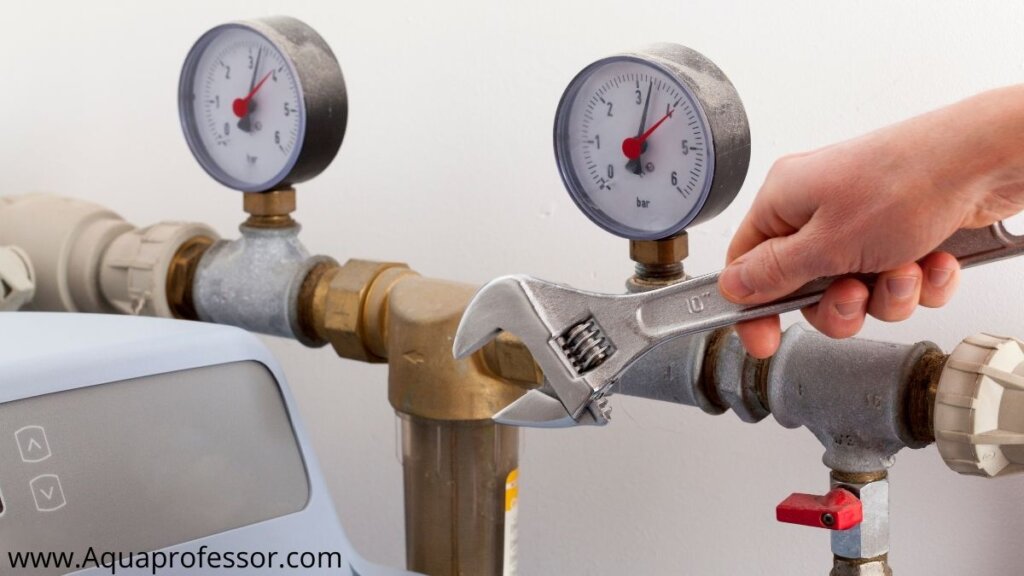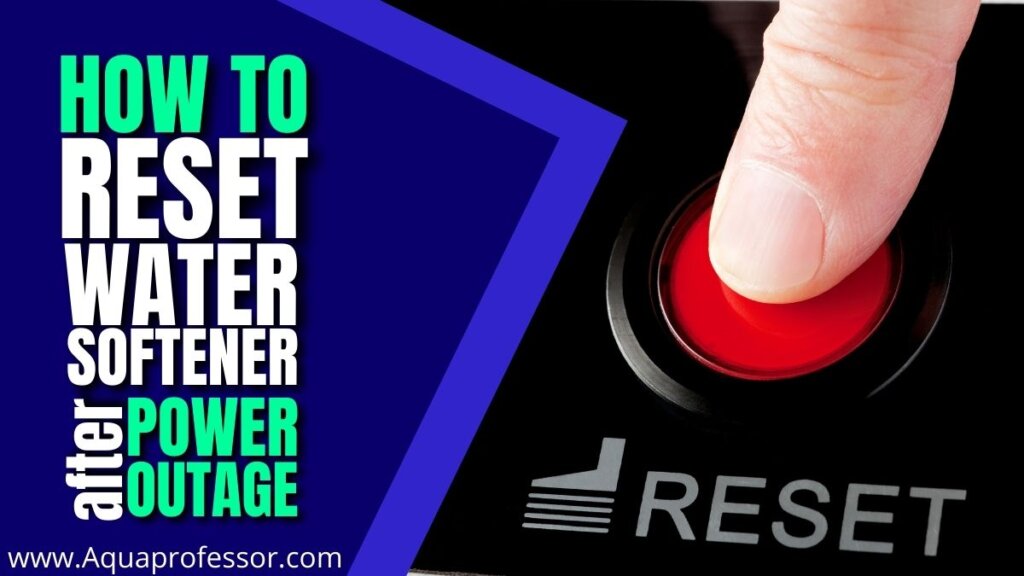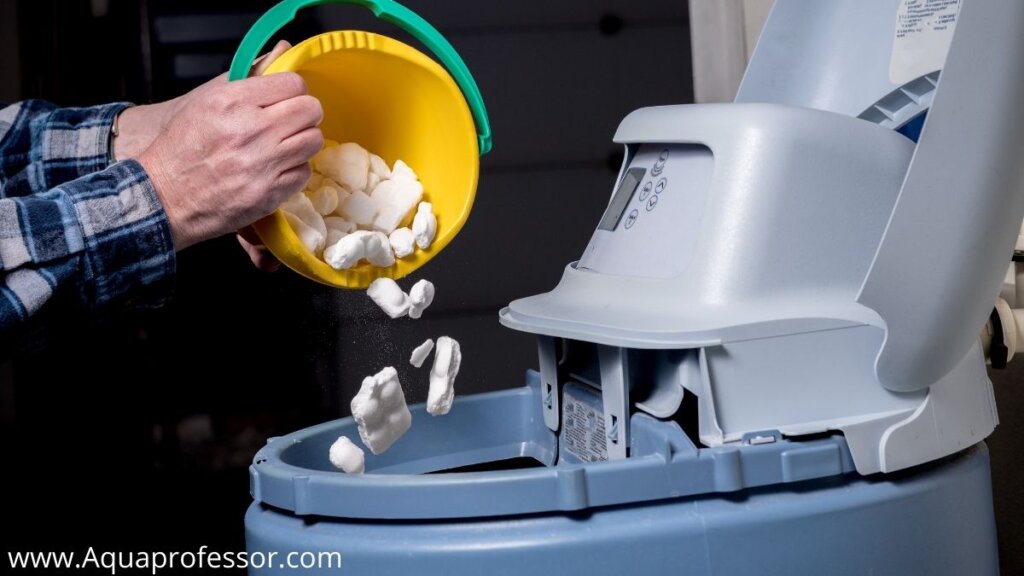![How to Reset Water Softener [Tried & Tested Guide In 2022]](https://www.aquaprofessor.com/wp-content/uploads/2022/06/How-to-Reset-Water-Softener-Tried-Tested-Guide-In-2022-1024x576.jpg)
There’s no denying that water softeners are necessary to treat hard water into soft water. So, you may find yourself in a position where you need to reset your softener to factory settings, such as after a power outage or after adding salt.
This is because softeners lose their settings during a power outage, causing them to go out of sync once the power has returned.
But don’t worry; we are here to help you with how to reset the softener. So read on because we’re going to guide you on how to reset a wide variety of water softeners in a few easy steps.
👉How Do You Reset a Salt Water Softener (10 Easy Steps!)

If you have a saltwater softener such as Pentair (check its whole house filters too!), AO Smith, or Culligan, here are the steps to reset its regeneration cycle:
Also Read: What If You Used Pool Salt In Water Softener?
🤔How to Reset Water Softener After Power Outage Safely?

Now we will move on to resetting softeners after a power outage. While the latest softeners do not require a reset when there is a simple power outage, you will require a reset to put everything back in sync again if using an older model.
Disclaimer:
The steps for resetting softeners that we have shared in this guide are based on our research and a general understanding of resetting softeners. Readers should go through their water softener’s user manuals to ensure there isn’t any critical information they might be missing out on.
Now back to guiding our readers about resetting softeners after a power outage! Follow these steps:
⌛How to Reset Water Softener Regeneration Time
Also Read: Best Natural Ways To Soften Hard Water [Cheatsheet In 2024]
⏲️How to Reset Water Softener Timer
It is essential to ensure that your softener displays the correct time of day; otherwise, the regeneration will happen according to the time displayed in the softener instead of the actual time.
Also Read: How Often Should You Refill Water Softeners?
🎯How to Reset Demand-Initiated Water Softener [Spoiler Ahead!]
Depending on water consumption and hardness levels, demand-initiated softeners regenerate by themselves. After a power interruption, you may not even need to reset these softeners. If they do not utilize an electric timer, they may continue to run regardless of power.
However, what happens if you need to reset this type of system for some reason, even if they have a timer?
In that case, you’ll typically only need to input your water use and hardness so that the system will regenerate precisely after so much water has been consumed.
Refer to your user manual for other specific information about your softener’s model.
Also Read: Water Softener Keeps Draining [Fixed]
✍️Should You Manually Regenerate Your Water Softener: Here’s the Truth

A softener’s crucial functions include regeneration. In fact, looking for an odd regeneration cycle is one of the best methods to identify whether something is wrong with your softener.
Mineral deposits are flushed from your softener’s resin tank beads during regeneration. Those beads would get too thickly encrusted with minerals to operate effectively without this treatment.
You can manually start a regeneration cycle on most systems. It’s not an exact science to figure out how often you should manually replenish your softener. If your system works correctly, you shouldn’t have to do this frequently.
If you go on vacation, though, you might wish to turn off the automated procedure and manually restart it when you return, rather than letting it automatically resume.
Also Read: How to Fix Low Water Pressure From Water Softener
The regeneration process relies on the salt you give to the softener to replenish the sodium the resin tank beads require to function correctly.
You may face periods of heavy water usage, the presence of extra occupants in the building or when you have to run extra loads of laundry. In these situations, taking gallons of water, a manual regeneration of a softener, allowing it to backwash and then recharge the salt treatment of the resin in the treatment tank will be helpful.
We sometimes do a manual regeneration cycle to ensure the softener regeneration procedure is operating. During a reset, it is recommended to use the bypass valve to direct away water from the system.
The vast majority of residential softeners have automated regeneration systems for softened water. These devices employ a clock or monitor the quantity of water used (demand-initiated regeneration softeners) to signal the softener when it has to shut down and regenerate.
If your softener lacks an automated regenerator, you must manually renew the softener. Even though your softener has an automated regenerator, you will need to renew it occasionally for routine maintenance.
Also Read: How To Drain Water Softener Full Of Water
💡How to Reset a Water Softener: FAQs
How long does it take for your water softener to reset?
A typical softener takes 85 to 90 minutes to complete its automated regeneration cycle. The softener cleans the treatment medium during regeneration by reversing the chemical process that eliminates undesired dissolved minerals. With the dissolved minerals removed, the cleansed treatment medium is ready to extract additional minerals from your water. When troubleshooting a softener, you may wish to perform each regeneration process manually.
The regeneration process begins with a backwash, which involves the softener pumping water backwards through the treatment medium to remove sediments. This sediment removal process takes roughly ten minutes. Then the softener pulls salt brine from a resin tank. It pumps it back to the resin tank through the treatment medium to chemically clear up the undesirable hardness minerals from the resin tank and flush them down a drain. This step takes around 50 to 60 minutes.
The softener then flushes the salt brine out of the treatment medium and down the drain, preparing the cleansed treatment medium to treat additional water. This takes around 10 to 15 minutes. Now open the brine tank lid, as the final stage is replenishing the brine tank with water to produce additional brine for the next regeneration.
How do you know if my water softener is clogged?
Before you leap to conclusions and diagnose a blocked softener, be sure there isn’t another reason your softener stopped operating. The first step is to determine what is wrong with your softener.
If you purchased your softener recently, it has an automatic system that monitors your water consumption and regenerates when it reaches a set quantity of litres. If your softener is older, you must configure the regeneration process when the provider installs it in your house.
When the softener becomes blocked, it is generally due to a salt buildup in the brine tank, but this is not the only option. It might also indicate that the softener drain or the pipes are clogged or have sustained damage. The most straightforward approach to determining what’s going on is monitoring your softener’s regeneration timetable.
Can a power surge damage a water softener?
Smaller electrical power surges can occur within the home’s electrical equipment, causing more damage to other appliances. Homes are vulnerable to harm when local electrical power spikes occur. Switching on an appliance uses power, disrupting the voltage supply to the rest of the house.
When it is turned off due to a power surge, it feeds electricity through the wires from the power sources, and when the power returns, it might damage other electrical equipment.
This includes your softener, and it’s one of the most expensive equipments to fix if it is electrically damaged, especially when it is the internal components. The most effective position against power surge damage is to install whole-house surge protection at your home’s primary power source. Power strips are also advised at outlets to prevent point-of-use power spikes.
How will I know if my water softener is regenerating?
Water softeners “sense” when it’s time to renew in two ways. The first is referred to as time-initiated regeneration. The system will regenerate at a predetermined period, commonly once weekly in the early morning hours. You should be able to tell by the water’s hardness.
You should be able to verify your softener’s settings and establish the particular interval whether it regenerates using this way.
Demand-initiated regeneration is another approach that softeners frequently employ to renew. The system regenerates purely based on your water use. This strategy makes tracking regeneration a little more complicated. However, typical units renew every two to three days, although highly efficient units may regenerate daily. To completely grasp your softener’s routine, refer to its user manual and monitor it.
Should there be water in your water softener salt tank?
The salt tank in your softener should never be full of water. Even if your water softener salt tank is half full of water, you have a problem and need to contact a professional.
Adarsh is a Health & Nutrition Sciences graduate with expertise in environmental health. He is associated with ventures like Glacier Fresh Filter and Simpure Filter Systems. Through Aqua Professor, he intends to provide helpful information to every home to help them make smarter decisions.
